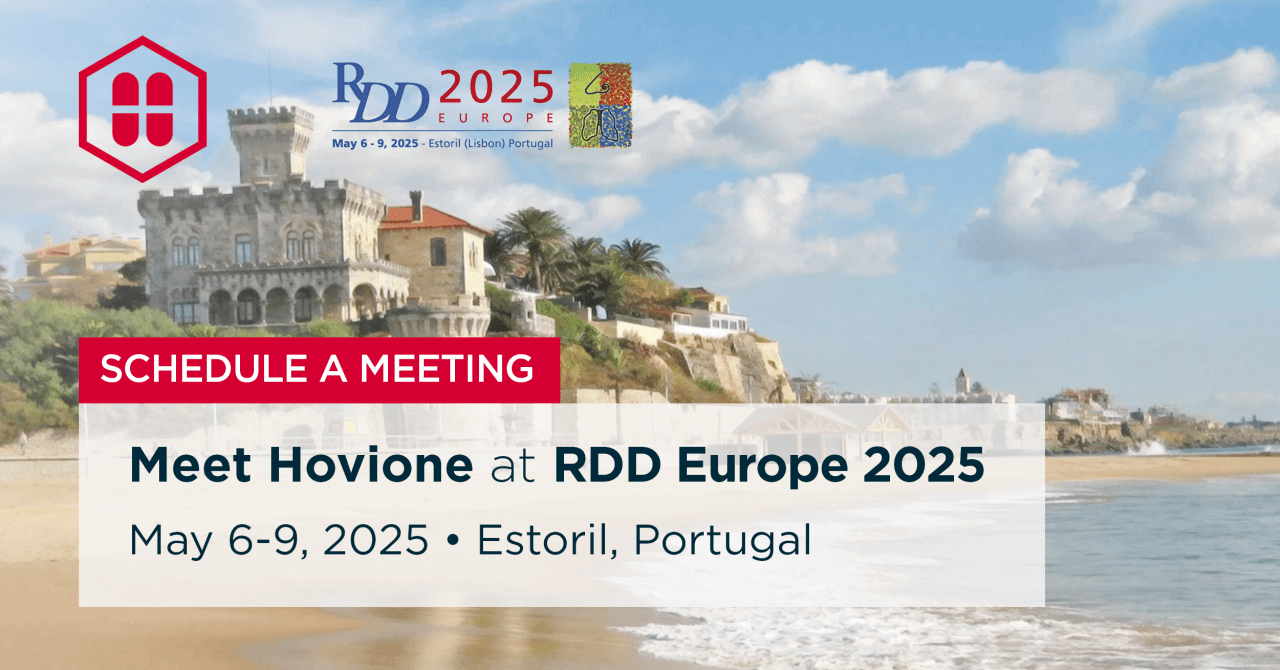Hovione is exhibiting at RDD Europe, a conference that has earned a sustained reputation for impactful, actionable content covering all aspects of drug delivery to the lungs and nose. In-depth presentations and discussions on pioneering science are expected to attract an audience of 500 delegates.
Do not miss the chance to meet our experts at table #23 and attend our podium and poster presentations, and workshop sessions.
Hovione Podium Presentation – May 7
Title: β-Lactoglobulin - A Novel Excipient for Next Generation Spray-Dried Powder Formulations
Session: May 7th at 11:30AM
Location: Auditorium
Presenters: Paulo Lino. Ph.D. in Pharmaceutical Sciences. Senior scientist. Inhalation and Advanced Drug Delivery
Moderator: Paul Young, Ph.D., Macquarie University, Sydney, Australia
- Short description: This study explores the potential of β-lactoglobulin (BLG) isolated from bovine whey as a novel excipient in dry powder formulations for respiratory delivery. BLG formed dispersible and high-density composite particles via spray drying.
- Key learning: Key findings include
- i) optimized spray drying conditions to obtain BLG particles with high fine particle fractions up to 90%;
- ii) demonstrated BLG compatibility with active pharmaceutical ingredients like fluticasone furoate and tobramycin;
- iii) stabilization of amorphous fluticasone;
- iv) high nasal deposition of BLG-based formulations
- v) pulmonary and systemic clearance in rats within 24 hours after being inhaled, with minimal immune responses and no observed toxicity.
Hovione Podium Presentation – May 9
Title: Leveraging Nasal Powders for Complex Therapeutics and Targeted Delivery
Session: May 9th at 11:00 AM
Location: Auditorium
Presenter: Patricia Henriques Ph.D. Scientist. R&D, Inhalation and Advanced Drug Delivery
- Short description: This presentation explores the potential of nasal powder delivery as a platform for systemic and targeted administration of complex therapeutics. By leveraging advanced formulation strategies, we address key challenges in delivering poorly soluble small molecules and biopharmaceuticals. The talk will highlight particle engineering approaches for targeted delivery, integration with tailored delivery devices, and insights from the development pipeline, showcasing how these innovations converge to enable effective intranasal therapies.
- Key learning: Understand how formulation for complex therapeutics influences the performance and clinical potential of effective nasal powder products. Explore how particle engineering and device strategies can be optimized to achieve targeted nasal delivery, enhancing patient compliance and therapeutic outcomes
Hovione Workshop – May 7
Title: Optimizing Biologics Powder Formulations: Achieving High Drug Load, Stability, and Efficient Inhalation
May 7th from 2:00 PM to 6:00 PM
Sessions: 2:00-3:00; 3:15-4:15 and 4:30-5:30PM
Location: Level 0 Room D3
Presenters:
Luís Marques, Senior Scientist – R&D, Inhalation and Advanced Drug Delivery
Filipe Vultos. Ph.D. Senior Scientist II. R&D Analytical Department
- Short description: Get to know Hovione´s integrated formulation-device solution for nasal powders development and learn how the early-stage in vitro screening may be predictive of the in vivo nasal powder performance.
- Key learning: Interest in developing biologic drugs for inhalation delivery has surged in recent years, primarily due to the advantages of the inhalation route over the parenteral route, especially for respiratory diseases. The main challenge in developing biologic formulations is maintaining the integrity of the biologic during formulation, manufacturing, storage, and delivery to the patient. Dry powders are preferred for inhalation delivery because they offer greater convenience and stability compared to liquid formulations. However, temperature and shear stress during manufacturing can affect the integrity of biologics. This workshop explores key formulation strategies to overcome these challenges, aiming to achieve dry powder formulations for biologics that not only exhibit good stability but also improved aerosolization performance and high drug loads.
Hovione Posters
Poster P12 - Nasal Spotlight
Title: Characterization Study of Nasal Deposition Targeting the Central Nervous System
- Authors: Cláudia Sofia de Pina e Costa. Ph.D. Analytical Scientist. Analytical Development
- Key Learning: Highlight the impact of different formulation particle sizes and nasal casts geometries in the deposition within the nasal cavity of the nasal dry powder
Poster P1 - Bench to Bedside
Title: Distinct Baseline Phenotypical and Functional Properties of Macrophages Derived from Two Different Lots of THP-1 Monocytes for Screening the Effects of Inhalable Drugs
- Authors: Alexandre Ribeiro. Ph.D. Principal Analytical Scientist. R&D. Hovione. Mykaella Mestre M.Sc. Ph.D. Candidate. R&D. Hovione & IST- University of Lisbon, Ibb
- Key Learning: Show potential sources of variability in the use of macrophage-like cells derived from THP-1 monocyte as drug development tools. Proposes analyzing cellular properties related to inflammatory function and API uptake as quality standards for these cells
Poster P2 Bench to Bedside
Title: Advancing High-dosage DPI Formulations: Integrating Quality By Design For Optimized Performance
- Authors: Rui Churro. Ph.D - R&D Manager, Inhalation and Advanced Drug Delivery
- Key learning: This work successfully integrated advanced modeling and Quality by Design (QbD) principles to optimize dry powder inhaler (DPI) formulations, enhancing process efficiency and product consistency. The development of a leucine "fingerprint" model and empirical tools for composite DPI formulation streamlines development and de-risks scale-up, offering significant business value through reduced R&D timelines, improved product quality, and faster time-to-market for inhalation therapies
Poster P12 Aqueous Agenda
Title: Optimizing Inhalation of a Monoclonal Antibody: Transitioning from Nebulization to a Dry Powder Inhaler
- Authors: Luís Marques, Senior Scientist – R&D Inhalation and Advanced Drug Delivery
Contact our experts today to learn how the Hovione team ensures that your inhalation and nasal therapies are engineered for success from start to finish.
Let’s discuss your project together. Schedule a meeting today.



